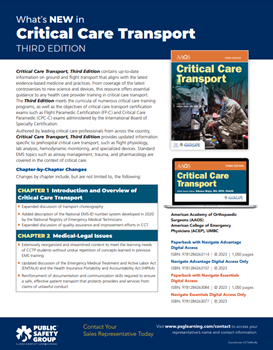New Trends in Critical Care

The field of critical care is changing quickly, and it's important to stay updated. Catch up on the latest trends in critical care and critical care concepts in the industry affecting health care providers and medical professionals alike, all of which are addressed and found in the Third Edition of Critical Care Transport.
Changes in Medical and Legal Issues
Medical and legal fields continue to have a significant amount of overlap, and recent changes have been made to the Emergency Medical Treatment and Active Labor Act, also known as EMTALA. In addition, some changes were made to the Health Insurance Portability and Accountability Act, also known as HIPAA. Critical Care Transport, Third Edition has received updates to reflect the most recent changes in these critical regulations.
Changes in Patient Safety
Patient safety remains paramount in the critical care transport, and a number of changes were made to the corresponding Critical Care Transport, Third Edition chapter 3 to reflect new information related to various reporting requirements and databases. Now, students have access to a number of strategies that they can use to reduce the chances of medical errors taking place that would otherwise impact their ability to provide appropriate care to their patients. The goal is to improve the ability of EMS professionals to provide exceptional care to patients while keeping them safe from harm.
Changes in Patient Assessments
The first few minutes are critical, and it is important for EMS technicians to conduct a quick, accurate assessment of the patient to figure out what to do next. Some of the changes that took place in this chapter include:
- The assessment process has been reorganized, making it easier for students to follow along and decide what to do next.
- A problem-focused review of all systems included in their primary assessment has been added to give students the high points they need to remember.
- A new discussion of hemorrhaging patients was added, giving EMS professionals an inside look at what they should do to stabilize the patient.
Changes in Respiratory and Ventilation
The respiratory system is one of the most common reasons why people reach out to emergency medical services. A few of the changes that took place in this section of Critical Care Transport, Third Edition include:
- A new discussion of the fundamentals of gas exchange has been added to reflect the most recent updates in the field.
- The assessment and management of the patient’s airway have been updated to make it easier for students to figure out how to best support the patient’s breathing.
- A new chapter has been added that is entirely devoted to ventilatory support. This includes the mechanics of ventilation, different modes of ventilation, and options for ventilatory management.
Changes in Resuscitation and Shock
Changes have also been made in the way Critical Care Transport approaches the issue of shock. Cardiogenic shock has received an expanded discussion, and guidelines were updated for large volume resuscitation and emergency reversal of oral anticoagulants. This is a common cause of shock in the field.
Furthermore, sepsis recognition remains a critical part of Emergency Care. This chapter in Critical Care Transport, Third Edition was updated to make it easier for students to understand how to recognize and respond to possible septic shock.
Changes in Trauma
The way trauma is treated in critical care remains a constantly updated filed of learning and adjusting for better patient safety. There is now a revised overview of different trauma center levels that will make it easier for EMS professionals to decide the appropriate destination for the patient.
In addition, the lethal triad of coagulopathy, acidosis, and hypothermia has received an overall update. Now, the information is presented in a manner that makes it much easier for students to rapidly digest and understand.

Critical Care Transport Remains a Cornerstone Resource
Ultimately, the singular goal of all of these changes is to make sure students have access to updated, relevant, and quintessential information that is presented in a way professionals and critical care students can best understand. By addressing current trends and issues in critical care, students will have an easier time learning the information they need to provide timely care to their patients. These current trends in critical care are an important part of the education process.
 If you’re interested in taking a look at all the updates by chapter in this Third Edition, click here. Fully review the latest trends in critical care transport and the latest evidence-based medicine and practices in critical care concepts with Critical Care Transport, Third Edition as a training system and resource that thoroughly prepares medical professionals for certification in the field.
If you’re interested in taking a look at all the updates by chapter in this Third Edition, click here. Fully review the latest trends in critical care transport and the latest evidence-based medicine and practices in critical care concepts with Critical Care Transport, Third Edition as a training system and resource that thoroughly prepares medical professionals for certification in the field.